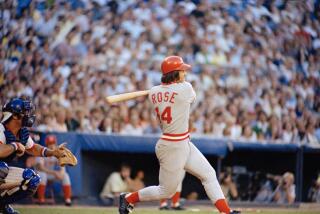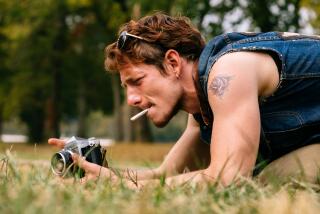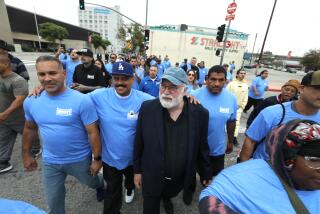Spiraling birds set man’s life straight
Bobby Wilson, a.k.a. Kill Kill, is a roller pigeon fancier -- has been since he was a little boy in the projects in Watts.
He was walking his dog down Holmes Avenue when he first spotted the birds flying above Eddie Scott’s house. He watched in wonder as they whirled and somersaulted through the sky. Bobby was 9 years old and a serial collector of animals -- spiders, red ants, hamsters, lizards. But he’d never seen this.
“You better not come in my yard!” Mr. Scott barked. Someone had just stolen a few of his top rollers and he was not happy.
The year was 1981. Mr. Scott drove a city trash truck, owned one of the nicest houses in Watts and had no tolerance for wayward children. He’d raised pigeons since his own childhood in the early 1960s, and some of his rollers came right down the line from the world’s great prophet of roller pigeoning, William H. Pensom, the late English master who lived over the hill in Canoga Park.
Bobby wasn’t going into Mr. Scott’s yard, but he sure as heck was coming back. Day after day he sat under the big shade tree across the street and watched those birds do their acrobatics, spiraling up and then wheeling down like falling angels.
“Come here,” Mr. Scott finally said one day.
He took Bobby out back and showed him the cages -- all scabbed up with dried pigeon waste. If the boy would clean ‘em out, he could have some baby squabs.
A couple of hours later Bobby rolled into his Jordan Downs housing project in Mr. Scott’s pickup truck with a grin and 10 squeaking squabs in a wooden box.
He was a roller man now.
Backyard hobbyists in Southern California raise pigeons of every caste and character -- homers, tumblers, rollers, tipplers, parlors, fantails, Jacobins, muffs.
But in South Los Angeles, rollers rule the sky.
Birmingham roller pigeons came from coal country in England, bred for a genetic quirk that compels them to launch into a streak of backward somersaults as they soar through the air. For over a century in England, they were a working-class pigeon -- cheap and spectacular to watch.
When Pensom, the world’s foremost authority on the birds, arrived in Southern California in 1950, people trekked out to his lofts in Canoga Park to buy his birds and seek his advice. The English fancy grew and roller clubs popped up all over town, holding auctions, lawn shows and contests. In flyoffs, judges traveled from house to house to watch competitors’ birds roll, rating them on the distance of the tumble, the tightness of the spin and the number of pigeons tumbling at once. Winners usually got a trophy, and hoped ultimately to be deemed a “master flier.”
Like ham radios or model ships, this was a man’s hobby. Roller men often fiddled in their plywood lofts well past dusk, enduring spousal complaints, trying to breed a pigeon that would roll farther, faster and tighter.
Why roller pigeons roll is a mystery. The behavior has no known evolutionary advantage. Some breeders speculate that they are suffering seizures. But the birds appear to be under control -- as if they’re simply overcome with the urge to do a few flying back flips.
There is no way to train a bird to do this right. It’s all in the breeding. Once the pigeons burst into the air, they are on their own. Nowadays a good roller can fetch hundreds of dollars for its breeding potential.
Unfortunately, hawks and falcons see this cartwheeling flesh as a snack falling from the heavens. They can ruin months of work in an instant, and are the bane of roller men everywhere.
These are not ragged, bruising street pigeons. They have apple-shaped chests and a sheen to their plumage. A combination of a mother’s warm care and a eugenicist’s cold scheming go into their upbringing. And the best have a plucky, collected character.
It can take years of trial and error to get a good team, called a kit, bred and rolling well. Like an old-world apprenticeship, roller knowledge is hard-earned -- passed gradually, if at all, to the rare neighborhood kids who show a spark for the birds.
Bobby propped his baby pigeons on the roof outside his bedroom window, where no one could get them. He cleaned them, fed them and took comfort in their cooing in the middle of the night. He marveled at their colors and patterns -- blue grizzles, red checks, duns, black and whites.
He got so into the birds that he gave away all his other animals, even his dog.
He’d race out whenever Eddie Scott blew his horn. “Come on boy, I need my cages cleaned! I got three squabs for you.”
Mr. Scott built him a loft -- wood frame, tin siding -- and set it up next to Bobby’s front door. Bobby holed up in that little shed so much that people in Jordan Downs took to calling him Birdman.
“I was able to escape a lot of stuff inside my pigeon cage,” he says.
But in one of the most violent projects in the city, Bobby didn’t escape everything.
From inside his loft when he was 12, Bobby saw a man get his head blown clean off. He was so scared he didn’t move for hours. The next day the gangbanger who did the deed marched up to Bobby, put the murder weapon to his head and threatened to kill him if he talked. Bobby peed in his pants. “I didn’t see nothing,” he stammered.
The final blow to his spirit came shortly thereafter, when Bobby woke up to find someone had broken the lock and stolen his birds.
His childhood quickly fell prey to the outside world. Bobby started transporting drugs for the killer and rolling with his “hood.” He landed in youth camp for assault with a deadly weapon, then in Old Folsom prison for attempted murder; that’s where he got the nickname Kill Kill.
But Bobby Wilson would never forget his birds. He’d sit in his cell, tracing them through the sky in his mind.
Whiling the hours away in his little loft was the idyll of his youth.
And passing that bit of transcendence down the line would be his shot at redemption.
When he got out of prison at age 21, Wilson put a kit together with his friend Ricky, who lived just down the street from Eddie Scott.
Ricky’s 5-year-old brother Taisean couldn’t get enough of those twirling birds. The little boy shadowed the two young men in the backyard, pestering them with questions, scaring up the pigeons. Wilson let him pick out three he could call his own. Taisean loved to watch rollers fly. When they pirouetted with the afternoon sun behind them, they lit up like a shower of shooting stars.
He looked up to his brother and Wilson with great admiration -- he wanted to be just like them. But the pigeons were the good side of a troublesome equation. Ricky was a Grape Street Crip, cycling in and out of prison. Wilson was gaining cred as a gangsta rapper.
By middle school, Taisean was emulating them, acting tough and getting in trouble.
People didn’t really take Taisean seriously as a budding thug. He had the quick giggle and easy smile of a Laughing Buddha -- and was a whip-smart student and junior orator.
But the pressure to go down a bad road was intense.
“If you’re a young dude growing up around here,” Taisean says, “other gangbangers see you and they want to entice you to do drugs and join the gang. And if you’re not into that, that’s when they press you and pick on you and bully you.”
He had his sister drive him to a pet shop to buy some roller pigeons.
He hunkered down in his backyard trying to breed a good kit from different lines of pigeons. He left only for school, meals, sleep and to look for new rollers.
When Ricky was in prison, Wilson watched over Taisean. He came by to teach him what to do, gave him some more birds and cages, kept him focused.
Other pigeon wisemen chipped in. His old neighbor Eddie Scott helped out, and Taisean lingered at Keith London’s pigeon shop near the corner of Manchester and Western avenues. London was a respected, earnest competitor who was generous with advice for the younger hobbyists. The birds had kept him out of trouble growing up too.
Now 16, Taisean is more committed than ever. He tilts his head back to watch his pigeons rise and consolidate in the filtered light one recent afternoon. He is just 4 feet 8 and built like a jukebox. Gazing up at that lonely sky is calming, like being the only person in the big, calamitous city tuned in to a great cerulean refuge.
His mother sits at the patio table drinking water. She calls the pigeons “a godsend.” Taisean is aiming to study computer engineering at UCLA. His mother thanks the pigeons and Bobby Wilson for keeping him on track.
In the backyard of his mother’s house in Lancaster, Bobby Wilson steps out in the midmorning heat to fly his pigeons. At 36, Wilson is a tough, serious man with the weary voice of a hard-timer.
In his 20s, he started a record label, made seven of his own CDs, got married and had four children. But he continued to hang with his old homeboys from Grape Street, and got shot four times in Long Beach in 2003.
That prompted some soul searching. He covered up the grape tattoos on his arm and changed his rap name from Kill Kill to Keal. And just as things were looking up, he got snagged in a drug conspiracy case.
He ultimately beat the charge, but was convicted of having a shotgun in his studio. He served 19 months and lost his car, his house, nearly every possession -- and his wife left him for a job in Texas.
When he walked out of Avenal State Prison last year, he had a firm goal. He took his $200 in parole money and set out to start a roller pigeon magazine.
In January, he released the first glossy issue of Q.S.D.C.: An Urban Insight into the Birmingham Roller, naming the magazine for quality, speed, depth and competition.
On Page 9, he displayed one of his biggest points of pride, Taisean Williams.
“I’m a little young dude just back here raising my pigeons,” Taisean wrote. “If it wasn’t for my pigeons, I’d probably be around here robbing houses. I’d probably be robbing your house! So that’s why I love my pigeons.”
Wilson likes to think that all the wisdom Eddie Scott bequeathed him a quarter century ago now flourishes in this young roller man.
And he hopes his magazine will give the region’s roller clubs a needed a morale boost. In May 2007, U.S. Fish and Wildlife officials in Los Angeles arrested seven prominent breeders and charged them with misdemeanors for trapping and killing the hawks that were attacking their birds in midair.
For a year, a federal agent had infiltrated local roller clubs, posing as a newcomer to the hobby. He bought hawk traps at a pigeon show and did surveillance from an unmarked vehicle.
When the agency announced the results of Operation High Roller, roller pigeon fanciers were in the news as they never had been before -- as hawk killers.
Now they say they’ll have to put up with the predators. The majority of the hawks migrate down from the mountains in fall and leave in spring. So most breeders ground their pigeons from September to March. But they say the flying window gets smaller every year.
In the yard, Wilson watches his birds cascade in opalescent waves across the blue emptiness, when a Cooper’s hawk shoots out of the weeds of a vacant lot and instantly zeroes in on the best roller of the bunch. The pigeon sees it coming and darts around like a bat from the rafters to stay out of its talons.
Wilson quickly throws up a loser pigeon for the hawk to eat. But the hawk is on the champion.
Predator and prey screech over the neighborhood in a fierce dog fight until the hawk suddenly gives up and disappears into the trees. Wilson’s kit is scattered all over the place.
“They’re spooked now,” he says. “Once they see that hawk, it’s like a gangbanger with an AK-47.”
They all come back after a few minutes. But the champion rolls deep and lands with a thud in the vacant lot.
Luckily, the ground is tilled and soft. The bird is still quivering from the chase, but uninjured.
And so goes the drama in Bobby Wilson’s world these days. No guns and drugs, he says, just birds.
The magazine is doing well, with 740 subscribers and growing. He’s back in the music studio as Mr. Keal. He’s raising his children and trying to get his wife to come back.
And sitting back watching those birds dance across the deep desert sky, he’s reclaimed something that was stolen from him a long time ago.
--
--
On latimes.com
Freewheeling fliers
To see photos and video of Bobby Wilson and his birds, go to latimes.com/rollerpigeons.
To see recent Column One articles, visit latimes.com/columnone.







